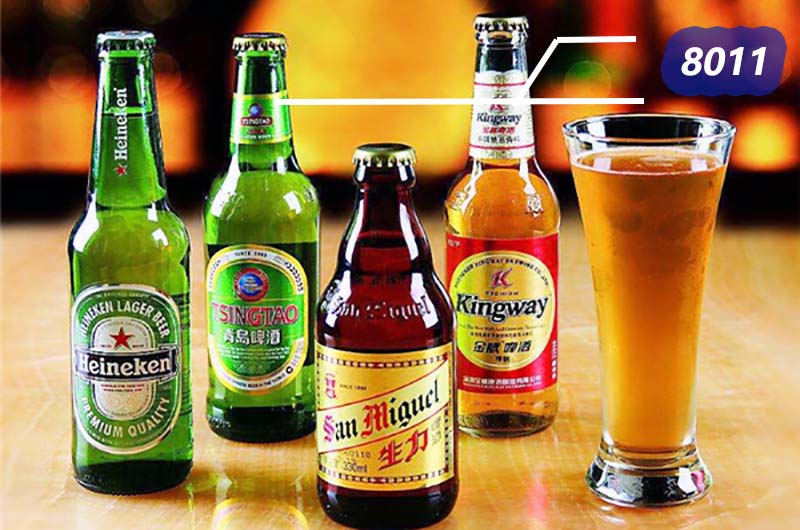- Why Aluminum Foil for Wine Bottle Caps?
- Aluminum Foil For Wine Bottle Caps Key Characteristics
- Aluminum Foil For Wine Bottle Caps Alloy and Specifications
- Frequently asked Questions (FAQ) Related about Aluminum Foil for Wine Bottle Caps
- People also ask about aluminum foil for wine bottle caps
Aluminum foil is not directly used for wine bottle caps, but is often used as a decorative material to cover the top of a wine bottle, providing a finishing touch to the packaging.
8011 aluminum foil heat shrinks to the neck of a wine bottle, providing a seal over the cork or cap, protecting it from external elements and contributing to the overall brand and image of the wine.

Why Aluminum Foil for Wine Bottle Caps?
Aluminum foil has become the material of choice for sealing wine bottles, offering a range of benefits that contribute to the preservation, presentation, and overall quality of the wine. Here's an in-depth look at the reasons behind the widespread use of aluminum foil in wine bottle caps:
1. Airtight Seal
Aluminum foil provides an exceptional barrier against oxygen and other external contaminants, creating a hermetic seal over the bottle neck.
This airtight seal is crucial for preserving the delicate flavors and aromas of the wine, preventing oxidation and ensuring a consistent tasting experience.
2. Light Protection
Exposure to light, especially UV rays, can lead to the deterioration of wine quality. Aluminum foil acts as a light barrier, safeguarding the wine from potential light damage.
The opaque nature of aluminum foil ensures that the wine's composition remains stable, preserving its color, taste, and aroma over time.
3. Temperature Stability
Aluminum foil aids in temperature regulation, preventing sudden temperature changes that could accelerate wine aging.
This stability is essential for wines that require gradual maturation and development, ensuring a more controlled and predictable aging process.

Aluminum Foil For Wine Bottle Caps Key Characteristics
- Thickness: Aluminum foil is relatively thin, providing flexibility for conforming to the shape of the bottle neck and allowing for heat shrinking during the application process.
- Printing Capability: The foil should be suitable for printing to allow for branding, logos, and other information to be applied. This involves surface treatments and coatings that enable the adhesion of inks.
- Embossing: Some wine bottle capsules feature embossed patterns or textures for visual appeal. The foil should be capable of undergoing embossing processes during manufacturing.
- Heat Shrinkability: The foil must be able to shrink when heat is applied during the capsule application process. This ensures a tight fit around the neck of the bottle.
- Barrier Properties: While not the primary purpose of the foil, it may have coatings or treatments that enhance its barrier properties, protecting the cork and wine from external elements.
- Compatibility with Closure: The foil needs to work seamlessly with the chosen closure type, whether it's a cork, synthetic closure, or screw cap.
Aluminum Foil For Wine Bottle Caps Alloy and Specifications
The most commonly used alloy for wine bottle caps is 8011, known for its combination of strength, formability, and corrosion resistance.
The foil is usually thin, ranging from 0.015 to 0.025 mm, ensuring flexibility for easy application while maintaining durability.
Thickness: The aluminum foil for wine bottle caps specifications are usually around 0.2mm, with an allowable tolerance of ±0.1%.
Width: The aluminium foil for wine bottle caps specifications range from 449mm to 796mm.

Frequently asked Questions (FAQ) Related about Aluminum Foil for Wine Bottle Caps
1. What types of wine use aluminum foil for bottle caps?
Aluminum foil is commonly used for sealing bottles of both red and white wines, including still and sparkling varieties. It is employed across a spectrum of wine styles and qualities.
2. Are there specific considerations for sparkling wines?
Yes, aluminum foil is often used for sparkling wines to ensure a secure closure that retains the effervescence. The foil helps maintain the pressure inside the bottle and prevents the loss of bubbles.
3. How does aluminum foil contribute to wine preservation?
Aluminum foil acts as a barrier against air and moisture, helping to preserve the quality and flavor of the wine. It contributes to the wine's longevity by protecting it from external elements that could lead to oxidation or spoilage.
4. Is aluminum foil recyclable?
Yes, aluminum is highly recyclable. The recyclability of aluminum foil aligns with sustainability efforts in the wine packaging industry. Consumers are encouraged to recycle aluminum materials to reduce environmental impact.
5. Does the color of the aluminum foil matter?
The color of the aluminum foil can be customized based on the winery's branding and aesthetic preferences. While silver is common, wineries may choose colored or embossed foils to create a distinctive and visually appealing packaging.
6. Can the foil be easily removed by consumers?
Yes, aluminum foil on wine bottle caps is designed for easy removal by consumers. It provides a convenient and user-friendly way to open the bottle while ensuring a secure seal before the first opening.
7. Does aluminum foil affect the taste of the wine?
No, aluminum foil is inert and does not impart any taste to the wine. It serves as a protective barrier without interacting with the wine's flavor profile.
8. Are there regulations regarding the use of aluminum foil in wine packaging?
Wine packaging, including the use of aluminum foil, is subject to regulations that vary by region. These regulations often cover aspects such as labeling, closure materials, and environmental considerations.
People also ask about aluminum foil for wine bottle caps
- Can you cover a wine bottle with aluminum foil?
- What kind of foil is used on wine bottles?
- What is the foil cap on a wine bottle called?
- How do you open a wine bottle with aluminum foil?
